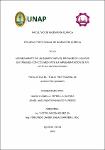| dc.contributor.advisor | García Pérez, Víctor | |
| dc.contributor.advisor | Salas Barrera, Fernando Javier | |
| dc.contributor.author | Estrella Guerra, Naomi Gianella | |
| dc.contributor.author | Panduro Paredes, Jahel Alexander | |
| dc.date.accessioned | 2024-01-30T17:24:48Z | |
| dc.date.available | 2024-01-30T17:24:48Z | |
| dc.date.issued | 2023 | |
| dc.identifier.other | 003.3 E92 2023 | |
| dc.identifier.uri | https://hdl.handle.net/20.500.12737/9755 | |
| dc.description.abstract | The objectify general of the present investigation it was: accomplishing the improvement of the team for the liquids drain in conical tanks, by means of the development of a system automated; being deduced firstly the intervening mathematical model which determined the passage of time to drain a certain quantity of liquid volume in conical tanks itself, Being applicable ad hoc the equation of continuity and the general equation of energy. From now on, the frame-up of the automated system came true, which was shaped by the following components: A programmable relay, the software Zelio Soft2 V5.4.2, the interface of communication, a valve solenoid, a red push-button NC, a green push-button NA, an indicating rookie pilot and a thermic key with its bipolar plug. At last, when moved in the aforementioned system automated in the conical tank, eight (8) performance testings, in the same ones that were determined the passage of time programmed in the automated system came true, which worked out: 58.6 s, 56.2 s, 59.1 s, 50.6 s, 49.0 s, 67.4 s, 59.5 s and 54.5 s, respectively. Also, they obtained the following results, regarding the maximum percentage of error, of the final level of liquid, of the final volume of liquid and of the draining volume, which were: 1.27 %, 3.85 % and 2.02 %, respectively, trying on this way, that to apply said mathematical model they obtain to the 95 % results with a bigger reliability. The present investigation this way is concluded, coming true with the objectify general al and trying on his general hypothesis. | en_US |
| dc.description.abstract | El objetivo general de la presente investigación fue: realizar el mejoramiento del equipo para el drenaje de líquidos en tanques cónicos, mediante la implementación de un sistema automatizado; deduciéndose primeramente el modelo matemático mediante el cual se determinó el tiempo para drenar una cantidad de volumen de líquido en tanques cónicos, aplicándose para esto la ecuación de continuidad y la ecuación general de la energía. A continuación, se realizó el montaje del sistema automatizado, el cual estuvo conformado por los siguientes componentes: un relé programable, el software Zelio Soft2 V5.4.2, la interfaz de comunicación, una válvula solenoide, un pulsador rojo NC, un pulsador verde NA, un piloto indicador verde y una llave térmica con su enchufe bipolar. Finalmente, al instalarse dicho sistema automatizado en el tanque cónico, se realizaron ocho (8) pruebas de funcionamiento, en las mismas que se determinaron el tiempo programado en el sistema automatizado, el cual resultó: 58.6 s, 56.2 s, 59.1 s, 50.6 s, 49.0 s, 67.4 s, 59.5 s y 54.5 s, respectivamente. También, se obtuvieron los siguientes resultados, con respecto al máximo porcentaje de error, del nivel final de líquido, del volumen final de líquido y del volumen de drenaje, los cuales fueron: 1.27 %, 3.85 % y 2.02 %, respectivamente; probándose de esta manera, que al aplicar dicho modelo matemático se obtienen resultados con una confiabilidad mayor al 95 %. De esta manera se concluye la presente investigación, cumpliéndose con el objetivo general y probándose la hipótesis general. | es_PE |
| dc.format | application/pdf | es_PE |
| dc.language.iso | spa | es_PE |
| dc.publisher | Universidad Nacional de la Amazonía Peruana | es_PE |
| dc.rights | info:eu-repo/semantics/openAccess | * |
| dc.rights.uri | https://creativecommons.org/licenses/by/4.0/ | * |
| dc.subject | Modelo de simulación | es_PE |
| dc.subject | Modelo matemático | es_PE |
| dc.subject | Equipos e instituciones | es_PE |
| dc.subject | Automatización | es_PE |
| dc.subject | Drenaje | es_PE |
| dc.title | Mejoramiento de un equipo para el drenaje de líquidos en tanques cónicos mediante la implementación de un sistema automatizado | es_PE |
| dc.type | info:eu-repo/semantics/bachelorThesis | es_PE |
| thesis.degree.discipline | Ingeniería Química | es_PE |
| thesis.degree.grantor | Universidad Nacional de la Amazonía Peruana. Facultad de Ingeniería Química | es_PE |
| thesis.degree.name | Ingeniero(a) Químico(a) | es_PE |
| dc.subject.ocde | https://purl.org/pe-repo/ocde/ford#2.02.03 | es_PE |
| renati.author.dni | 71245601 | |
| renati.author.dni | 70019481 | |
| renati.advisor.orcid | https://orcid.org/0000-0002-1408-6277 | |
| renati.advisor.orcid | https://orcid.org/0000-0002-0177-3553 | |
| renati.advisor.dni | 05277951 | |
| renati.advisor.dni | 05415003 | |
| renati.type | https://purl.org/pe-repo/renati/type#tesis | es_PE |
| renati.discipline | 531026 | es_PE |
| renati.level | https://purl.org/pe-repo/renati/level#tituloProfesional | es_PE |
| renati.juror | Flores Bernuy, Hugo Emerson | |
| renati.juror | Delgado Céspedes, Alcides Armando | |
| renati.juror | Ramírez Álvarez, Karenth Elena | |
| dc.publisher.country | PE | es_PE |





